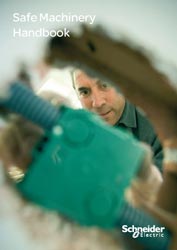
Posted to News on 29th Jul 2010, 06:01
Schneider Electric 'Safe Machinery Handbook' - a review
Schneider Electric has published the Safe Machinery Handbook, a 64-page book that is available to download as a PDF from its website. Although Schneider is a manufacturer of machinery safety components, the handbook has been written in an unbiased way to help machine builders and users to provide workers with machines that are safe, legal, and efficient. The authors also point out that it is not an exhaustive guide to compliance with safety legislation, and readers still need to refer to the relevant standards, but the handbook does provide a guide to the logical steps that need to be taken, and highlights the relevant sources of information that should be consulted.

The book is divided into nine chapters as follows:
- Introduction
- Why safety?
- Legal framework
- Risk assessment
- Safe design and safeguarding
- Functional safety
- Control system standards including worked examples
- Sources of information
- Annexes - architectures
Throughout the handbook good use has been made of examples, even down to showing the costs associated with an accident involving inadequately safeguarded machinery. Photos and other graphics are also used, sometimes to help explain the points in the text and sometimes merely as illustrations. Another useful feature is comments in the margin that draw the reader's attention to points that would not be obvious from the main text.
Legislation and standards
In the Legal framework chapter there is a clear explanation of the differences between European Directives, standards, harmonised standards, and Type A, B and C standards. In addition, the phrase 'presumption of conformity' is explained, and there is a link to the list of standards harmonised to the Machinery Directive (though beware that clicking on the URL in the PDF does not work, as the URL has broken across two lines).
While there is a helpful list of standards, readers need to check the current harmonised standards, as published lists of standards inevitably become out of date sooner or later. Moreover, the list of Type C standards for specific machine groups only contains a proportion of all C type harmonised standards. Note that most standards references within the handbook use the British standard numbers, such as BS EN ISO 12100-1, whereas the list of standards uses only the EN/ISO numbers as appropriate.
The Risk assessment chapter outlines the basics required for a risk assessment in accordance with EN ISO 14121-1, though it stops short of providing a worked example. However, this is understandable, given that risks can vary widely, depending on the machinery, the skill of the operators and whether anyone else - including children - might come into contact with the machinery.
Much of the Safe design and safeguarding chapter draws on the contents of EN ISO 12100-2 Safety of machinery. Basic concepts, general principles for design. Technical principles. However, there are also references to, for example, the Machinery Directive and residual risks.
Functional safety
With the move towards the adoption of functional safety for machinery, the handbook devotes an entire chapter to this subject. Starting with a look at the 'risk graph' found in EN 954-1, which was not a 'functional safety' standard, the handbook goes on to explain the concept and discuss the two applicable standards, namely EN 62061 and EN ISO 13849-1, and how to chose which one to apply. The following chapter gives a worked example, applying each standard to the same machine. This chapter will be very useful for anyone new to these standards, though care should be taken to select the correct standard for a given application, not just the standard that looks easiest to apply! For those using EN 62061, Annex 1 in the handbook shows system architectures; for those working with EN ISO 13849-1, Annex 2 shows the five different Categories and examples of the corresponding system architectures.
Towards the end of the guide is the chapter for Sources of information. This lists applicable UK legislation, standards, websites and documents from Schneider Electric. As mentioned above, where the PDF contains URLs that break across two lines, the links do not work; instead the full URL has to be copied and pasted into the browser. Fortunately the link to the UK's Department for Business Enterprise & Regulatory Reform is automatically redirected to the new site for the Department for Business, Innovation & Skills.
Follow the link to download a copy of the Safe Machinery Handbook (which is referred to on the page as a Machinery Safety Guide and a Safe Machinery Guide), and Schneider Electric has more resources relating to machinery safety on its Legislation web page.
* Review by Jon Severn, Editor, MachineBuilding.net.
Want the latest machine building news straight to your inbox? Become a MachineBuilding member for free today >>















